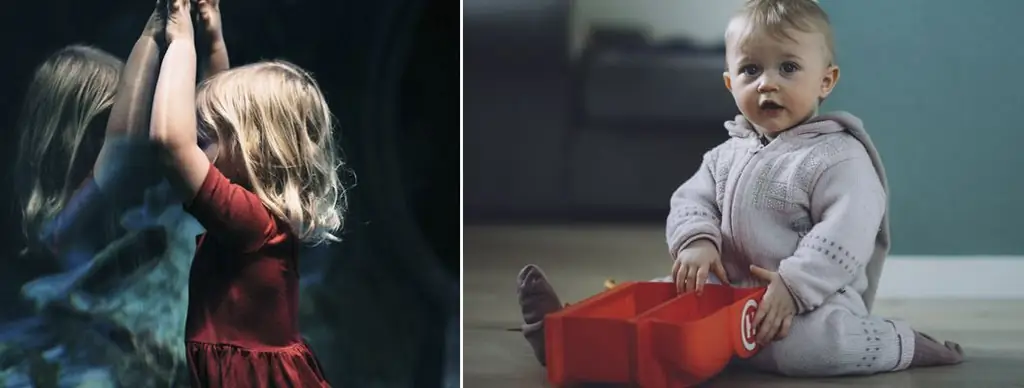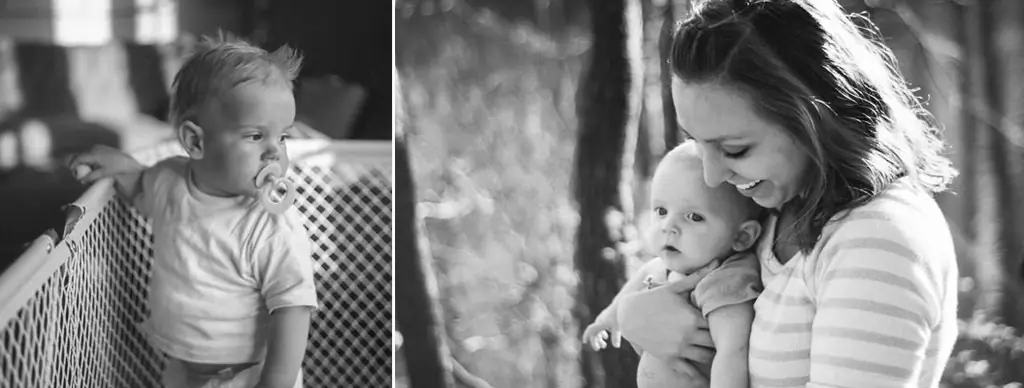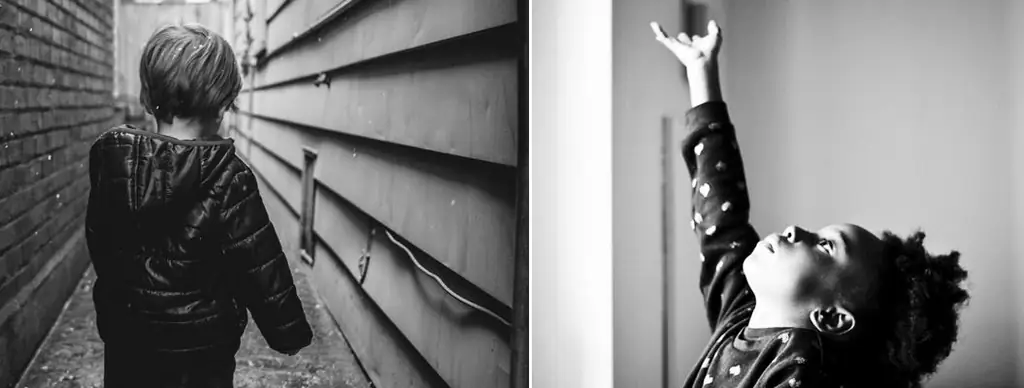- Author Adrian Jeff [email protected].
- Public 2023-12-17 05:06.
- Last modified 2025-01-24 14:09.

Signs of autism in children 3-4 years old
What about him? Children's doctors usually say that the exact signs of autism are determined in children 3-4 years old, earlier - the diagnosis is wrong. But just sitting and waiting is scary, unbearable. How do you know if your child is autistic or just an introvert?
You drive away the treacherous thoughts that something is wrong with the child. But they persistently creep into my head. It can be seen that your baby is not like the others: low-emotional, immersed in himself, does not like to look into the eyes. What about him? Children's doctors usually say that the exact signs of autism are determined in children 3-4 years old, earlier - the diagnosis is wrong.
But just sitting and waiting is scary, unbearable. How do you know if your child is autistic or just an introvert? The knowledge of the training "System-vector psychology" by Yuri Burlan will help to understand.
Childhood autism or personality traits?
To determine deviations in development, you need to push off from the norm. But comparing your child to other children of his age is useless. From birth, children are endowed with different mental properties. They directly affect the age at which a child learns a particular skill.
Only children with a sound vector are at risk of being diagnosed with autism. Such a child is born by nature as an absolute introvert. Outwardly, he has little emotion, speaks little. Avoids large, noisy companies. Reacts painfully to loud sounds. By themselves, such signs are not at all evidence of any violations. Just the ear is a particularly receptive zone of the speaker, as if a powerful speaker is mounted in it.
The little sonicist has a long way to go from birth to puberty to develop into his opposite. To become a person who, on the contrary, is as focused as possible on other people. He subtly hears the meanings in the speech of other people. Distinguishes any movement of the human soul.
But it happens that the development of a child with a sound vector is disturbed as a result of psychological trauma. Then his self-absorption becomes painful. The child loses emotional ties with loved ones, loses the ability to understand speech. How to determine if there is a reason to sound the alarm?
Signs of autism in a child under 3 years old
At the age of 1 to 3 years, you should pay attention to the following indicators:
1. Speech. Even a perfectly healthy child with a sound vector can speak later than his peers. Speech can be laconic: the child expresses a thought in one or two words.
Therefore, first of all, pay attention to whether the child understands your speech. Is he pointing or looking at the thing you named? Fulfills requests and actions with the items you are asking for? If not, this could indeed be a sign of violations. Point out that the child's conscious connection with the world, his ability to understand the addressed speech is broken.
2. Emotional response. An absolutely healthy child with a sound vector is not very emotional. He will not "gush" smiles. Great depth is inherent in his feelings, but outwardly he shows it little.
Notice how the child is involved, responsive to just being close to you. Do something together. Does he get upset when mom leaves? Shows joy when she returned? Maybe he doesn't react too brightly outwardly, but still gives a response smile? Does his mood change when his parents are chided for disobedience?
If so, everything is fine. It is worth being wary if the child does not provide any emotional response to your actions and feelings.
3. Reaction to the name. The speed of response to requests. It is important to take into account that even healthy adult sound professionals sometimes withdraw into themselves and may respond with a delay. Even a sound engineer may not respond to his own name on the first try: “Huh? You talking to me?"
In addition, the speed of a child's reaction will also depend on other vectors given to him by nature (modern urban children have about 3-4 vectors in the structure of their psyche).
So do not rush to conclusions, watch for a while. It is worthwhile to be wary if the child often does not respond to his name and requests.

4. Eye contact. One of the important signs of autism is considered to be the lack of eye contact in a child. But even here everything is ambiguous. Perhaps you have met people who, listening to you carefully, do not look you in the eye at all? On the contrary, slightly tilting your head to one side, turn your ear?
This is not a sign of pathology: this is how the sound engineer behaves when he focuses his attention on you. In a sense, he "looks with his ears." Therefore, this symptom alone, without the presence of other disorders, does not mean anything.
Observe how the child reacts visually in general to what you show. Watching, watching? Does your show repeat the movements you want? It is worthwhile to be wary if the child does not at all fix attention on those objects and actions that you demonstrated. When his gaze all the time "slides by".
5. Pointing gesture. How and to what extent a child uses the pointing gesture depends on the full range of his innate properties. For example, a child with a visual vector for this request can simply look for the desired object with his eyes, turn in his direction. The owner of the anal vector, especially attached to his mother, will let his mother down by the hand to give her favorite juice from the refrigerator.
It is better to assess, in principle, the child's desire and ability to interact with you. And his ability to understand what is at stake.
6. Game. A child with a sound vector is given the potential of abstract intelligence. Even the play of such a child at an early age can look abstract. For example, a kid with an anal-sound combination of vectors loves to organize, sort, build rows of blocks or cars. An audiovisual child can be delighted with playing with a switch, looking at objects in the light, etc.
By themselves, such manifestations are also not an indicator of pathology. In a sense, a kid with abstract thinking needs to be taught to play. Help him tie abstract fun to specific life situations. For example, let a row of blocks be a road, invite your child to build a house at the end of it. If the child makes contact, lets you into the game, supports it - there is nothing to worry about.
It is worth being wary if, with your intervention, the child loses interest in the game, turns away, leaves, categorically protests against your participation.
7. Interaction with other children. This indicator is secondary. It directly depends on how successfully the child can interact with the immediate environment.
If a child understands your speech, he has an emotional connection with his mother (and then the rest of the family), if he supports play and other joint actions with you, then he will be able to establish a connection with the children. It’s just that it’s difficult for a small sound engineer to adapt among noisy peers at first.

Concomitant signs of autism in a child under 3 years of age
The sound vector is dominant in the child's psyche. If its development is disturbed, then the properties of other vectors of the baby also cannot develop normally. Various kinds of behavioral anomalies are possible:
- in carriers of the skin vector, this is disinhibition, obsessive movements, pretentious postures and gestures;
- the owners of the anal vector - stupor, extreme viscosity of thinking, "ritual" in choosing food and walking routes;
- the owners of the visual vector have numerous fears, phobias, nightmares, tantrums, constant mood swings.
You cannot conclude that your child is autistic on the basis of these secondary signs. They can be the result of completely different psychological trauma or health problems.
Remember that there are only two main criteria for autism - a broken conscious and sensory connection with the world.
But if the behavioral anomalies described above are complemented by the main signs of autism, then there really is a reason to suspect this particular diagnosis.
Signs of autism in children 3-4 years old
- By the age of 3 or a little older, even the smallest introvert sound person should have speech. It may not be too detailed - laconic, but with its help the child expresses his desires, essentially answers your questions, interacts during the game and in everyday life. If speech does not appear at all after 3 years, this is a cause for concern.
- Many children like to repeat the same phrase several times. But if the child is simply obsessive and repeats the same thing many times, and this is not at all appropriate, not in meaning, then it is worth being wary.
- A sound child at 3-4 years old may still give a "delayed response", that is, not immediately respond to your request. But he must definitely know the names of household items, toys, find the necessary images in the book. And to fulfill requests, answer questions, even if with a slight delay.
- By the age of 3-4, a stable emotional connection with the mother should be formed and at least the first shoots of emotional ties with other people should appear. If the child is completely indifferent to the arrival and departure of the mother and other loved ones, constantly avoids contact with any people, this may be a sign of violations.
- Behavioral anomalies, if any, should also alert you (hyperactivity, obsessive movements, ritualism, stubbornness and aggression, auto-aggression, tantrums). Such indicators in any case indicate that there are problems in the development of the child. But it is possible to say that these are concomitant symptoms of autism only if you observe them, together with other disorders (points 1-4).

Diagnostics and the need for a psychiatrist's conclusion
Remember that you have no right to diagnose the child yourself. This can only be done by a competent specialist, a psychiatrist, based on a combination of symptoms and signs.
But with the help of this article, you can determine how justified your anxiety is. And the main thing is to find out the reasons why the development of a small sound engineer is disrupted. Get recommendations on what can be done to align its development.
Stages of child development and causes of deviations
A child receives psychological trauma that leads to the development of autism for two reasons:
- Sounds that are too loud can injure the especially sensitive ear of the sound engineer. This includes operating noisy household appliances, loud music, and an always-on TV or radio. But especially quarrels, scandals and screams in the family, offensive meanings in the speech of adults.
- The mother's severe psychological conditions traumatize the child's psyche. This could be ongoing stress (divorce, job loss, death of loved ones) or chronic stress due to life's troubles. And even the long-standing psychological trauma that my mother received many years ago. Fenced off from people can also arise from the lack of emotional connection with the mother - for example, she is forced to work a lot and the child spends a lot of time alone, in the company of "cartoons" or audio fairy tales. The child does not learn to interact with people, remains in introversion.
Depending on how and when the child was harmed, his impairments can manifest themselves at different ages:
- Today, more and more people talk about "congenital autism". But genetics has nothing to do with it. It's just that the sonic baby could actually get hurt while still in the womb. For example, if the mom was going through a lot of stress during pregnancy. Or was exposed to too loud noise influences (discos, concerts, work in a noisy workshop in production, etc.).
- Most often, doctors diagnose signs of autism in a child 4 years old or slightly younger (after 3 and before 4). Usually it looks like this: the child as a whole developed normally for up to a year, and then psychologically it was as if it was stuck at this age line. Both of the reasons described above play a role here.
- Less often, it happens that the signs of autism appear in the sound specialist in preschool or primary school age. Sometimes, with a clear regression in development, such a child is diagnosed with childhood schizophrenia.
What to do for parents and close people
If you suspect your child has signs of autism, take these steps right away:
- Create a “sound ecology” atmosphere at home. Eliminate quarrels and raised tone. Minimize any household noise. Talk to your child quietly and clearly so that he listens to the speech. In the background, quietly turn on classical music when the baby is busy playing - this is useful for the sound ears.
- Create as much "emotional ecology" as possible. A small sound engineer will withdraw into himself if you “gush with emotions”. Also, do not start playing or playing with your child if you feel that you are nervous or too tired.
The first step is much easier than the second. Because even hidden serious mother's conditions will harm the child. Nevertheless, there is a way out - in the event that the mother receives high-quality psychotherapeutic assistance.
Forecasts, recommendations, therapy
Childhood autism is a psychogenic disease. But it happens that the signs of autism appear in those little sound people who have a different pathology (genetic disorders, organic brain damage, etc.). In such cases, the main diagnosis cannot be removed by psychological measures, but the condition of the mother and child can be significantly improved.
If a child is physically healthy, his autism occurs only for psychological reasons. Depending on the severity of the deviations, the child's age and the mother's condition, such a diagnosis can be removed at the training “System-vector psychology” by Yuri Burlan. How does this happen?
- The mother receives information about the full set of inborn vectors of the child. She can build an ideal parenting model, taking into account all the natural properties of the baby. Developmental delays are compensated for by further normal development. As long as the child is small, it is possible.
- Mom receives high-quality psychotherapeutic assistance. Any obvious and hidden psychological problems go away from her. It becomes a stable source of safety and security for the child. Its development is leveling off.
The effectiveness of the training is confirmed by the results, which indicate that the diagnosis of autism and even childhood schizophrenia has been removed from the child.
You can get acquainted with the method and get first aid at the free online lectures by Yuri Burlan. To participate, register here.






